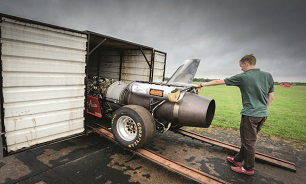How to (almost) break the UK land speed record
Despite having limited resources and ‘technology from the 1950s’, a group of keen volunteers almost succeeded in the feat.

Khodrocar - He wasn’t alone. Thousands of other youngsters followed suit when their record-breaking hero, Donald Campbell, died as his Bluebird K7 hydroplane plunged into the depths of Coniston Water during an attempt on the world water speed record.
1000mph Bloodhound SSC successfully completes first test
Far from being put off, however, David Tremayne – that teenager in the capital – was inspired and promised himself that one day, no matter what, he too would become a record breaker.
Half a century later, on 18 August 2017, Tremayne remembers that promise as he straps into his Team Duo Stay Gold gas turbine-powered car. He’s attempting to break the UK land speed record of 301.67mph. It is the culmination of years of struggle and planning, including searching for the right engine, the right car and enough funding. He’s backed by an equally dedicated nine-strong team that includes sons Tom and Sam, but money is always tight. "We’re a bunch of shoestring boys,” he laughs, "the absolute opposite end of the spectrum to Bloodhound SSC.”
With Stay Gold lined up on Elvington Airfield’s 3000-metre runway and the starter plugged in, the jet engine whirs, igniters crackle, the engine fires and Tremayne scans the instruments. The jet pipe temperature peaks at 1000deg C then settles to 650deg C, as it should. The engine idles at 40%, Tremayne’s left foot is on the dead man’s pedal and his right foot is hard on the brake. The fuel valve on the right of the cockpit is set to fully open and the throttle to closed.
Tremayne eases the throttle lever forward to spool the engine up to 100% without the afterburner, the noise increases, everybody moves back and he is given the signal to start. Tremayne looks towards a red light 2000 metres away, his focus point to keep him on track, holds down the ‘hot shot’ button, then fires the reheat to unleash the engine’s full 4000lb of thrust.
It’s the first time the team has managed to get the engine running with full reheat. On the first short run at Cotswold Airport in 2012, Tremayne hit 205.22mph before the ancient Rolls-Royce Viper 520 engine failed with a seized rear bearing. In 2013, the team bought two Viper 601s as replacements, but both were unusable, then acquired the current Viper 535. That also had a technical problem and refused to run above idle, but the real problem has been finding someone with the knowledge to fix it.
"Team members are all volunteers and we all have busy lives,” Tremayne later recalls. "Plus, we are dealing with technology from the 1950s and there’s nobody left from that period who knows anything about these powerplants.” Nobody, that is, until Tremayne talked to Bill Smith who, with his own Bluebird Project team, was responsible for recovering Campbell’s Bluebird K7 from its resting place in Coniston Water and restoring it.
"We were dying on our feet at the beginning of 2016 with nowhere to go,” says Tremayne. "Then Bill and his team went through the whole system and discovered a simple washer missing from the fuel pump.” With the washer replaced, the engine was tested on 4 January this year, the 50th anniversary of Campbell’s accident. The power rose beyond 50% for the first time, first to 93% and then, the next day, to 102%, before the pressurised front fuel tank split. Once that was repaired, the team made plans for a serious record attempt and the date was set for 17 August. Then, at a final test of the reheat at Carlisle Airport on 9 August, they found the engine had seized. A panel inside the jet pipe was fouling the turbine but, once freed, the engine seemed to run perfectly.
The following week, the team assembled at Elvington with the UK Timing Association. Tremayne strapped in to the cockpit for his first attempt. "It didn’t go well,” he recalls. "I managed 206mph, so in five years we’d improved by 1mph.”
Source: Autocar
Latest News


